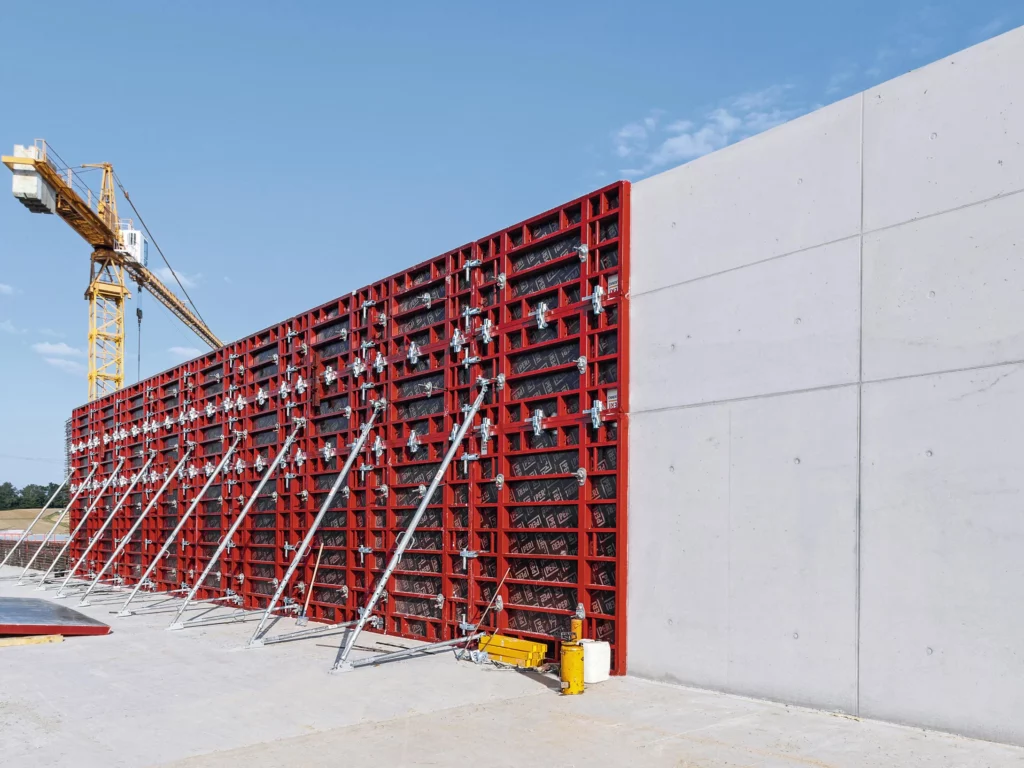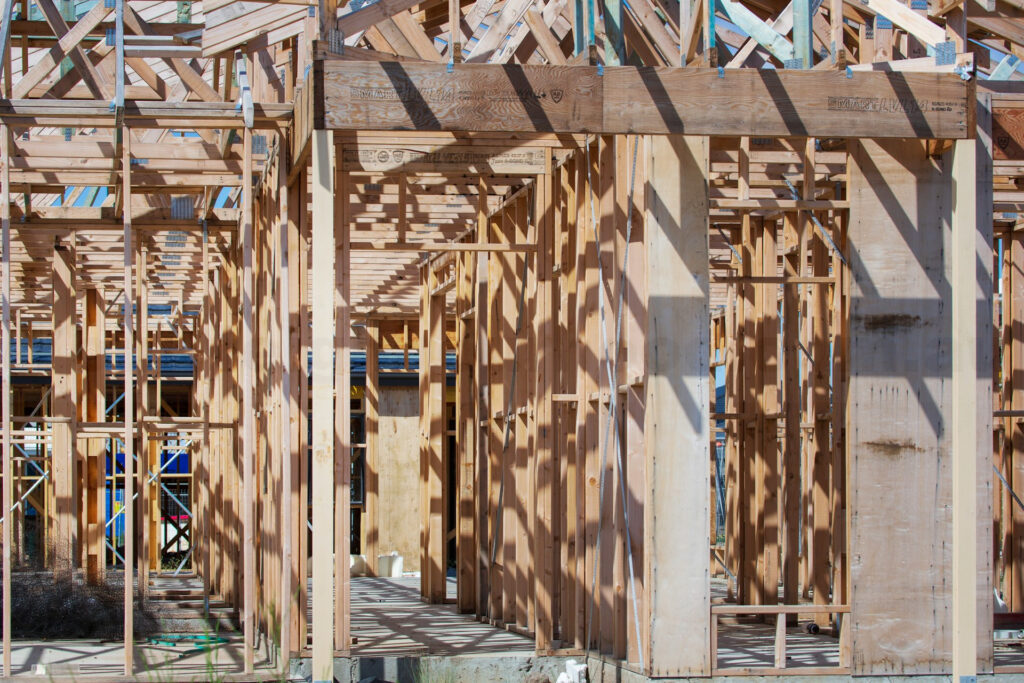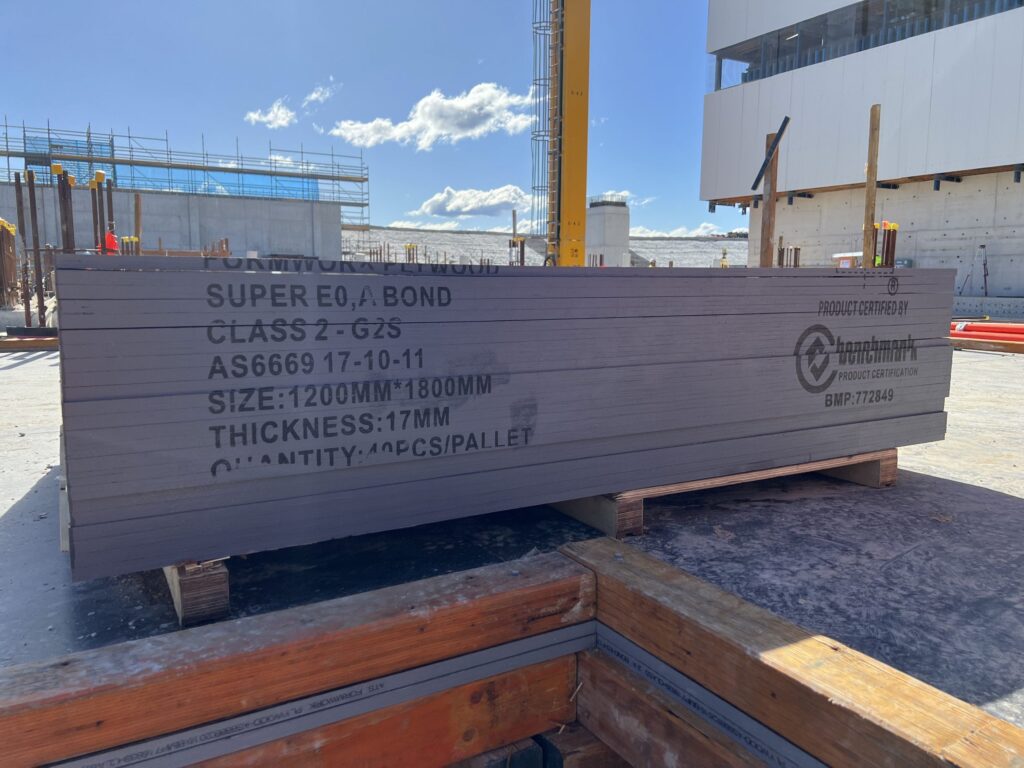How Can High-Quality Plywood Formwork Enhance the Strength and Smoothness of Concrete Finishes?
High-quality plywood formwork serves as the foundation for achieving exceptional concrete finishes in construction projects. The right formwork creates precise shapes, maintains structural integrity, and delivers smooth surface textures that define professional concrete work.
Your choice of plywood formwork directly impacts:
- Surface Quality – Premium plywood creates smoother concrete surfaces with minimal imperfections
- Structural Strength – Proper formwork supports optimal concrete curing and reinforcement placement
- Project Efficiency – Quality materials reduce the need for repairs and surface treatments
- Cost-Effectiveness – Durable plywood can be reused multiple times with consistent results
In this guide, you’ll discover essential insights about selecting and using plywood formwork, including:
- Best plywood types for different applications
- Critical thickness considerations
- Installation best practices
- Maintenance techniques
- Safety requirements
Understanding these elements helps you achieve professional-grade concrete finishes while maximising the lifespan of your plywood formwork materials. The right knowledge transforms standard concrete pours into durable, aesthetically pleasing structures that stand the test of time.

What Types of Plywood Are Best Suited for Formwork to Achieve Smooth Concrete Surfaces?
The selection of plywood species plays a crucial role in achieving flawless concrete finishes. Each wood type offers distinct advantages:
1. Birch Plywood
- Dense grain structure
- Superior strength-to-weight ratio
- Excellent resistance to warping
- Ideal for high-end architectural concrete
2. Poplar Plywood
- Lightweight yet durable
- Cost-effective option
- Suitable for standard construction projects
- Good dimensional stability
3. Spruce and Pine Plywood
- Readily available
- Moderate strength properties
- Best for short-term use
- Cost-effective for basic applications
4. HDO (High-Density Overlay) Plywood
- Resin-impregnated fibre overlay
- Up to 200 concrete pours per panel
- Superior water resistance
- Exceptional smooth finish quality
5. MDO (Medium-Density Overlay) Plywood
- Paper overlay bonded with resin
- 30-40 concrete pours per panel
- Good moisture protection
- Consistent surface texture
6. F14 vs F17 Grade Comparison
F14 Grade
- Standard structural grade
- Suitable for basic formwork
- Lower cost option
- 2-3 reuse cycles
F17 Grade
- Higher stress grade rating
- Enhanced load-bearing capacity
- Premium durability
- 4-5 reuse cycles
The choice between these options depends on your project requirements, budget constraints, and desired concrete finish quality. HDO plywood delivers premium results for architectural concrete, while F17 grade offers the best balance of strength and reusability.
Find more on: Scaffold Mesh vs. Scaffold Netting: What’s the Difference

How Does Plywood Thickness Affect the Strength and Finish of Concrete Formwork?
The thickness of plywood formwork plays a crucial role in determining both structural integrity and finish quality of concrete projects. Understanding the relationship between thickness and performance helps you select the right materials for your specific requirements.
Standard Thickness Ranges and Applications:
- 12mm – 15mm: Ideal for small-scale residential projects and light-duty applications
- 17mm – 19mm: Suitable for medium-sized commercial construction
- 21mm – 25mm: Recommended for heavy-duty industrial and infrastructure projects
Load-Bearing Considerations
Thicker plywood panels provide enhanced load-bearing capacity during concrete pouring. A 25mm panel can typically support:
- Up to 90 kPa concrete pressure
- Larger spans between supports
- Reduced deflection under load
Surface Finish Impact
While thicker panels offer superior strength, they can present challenges for achieving smooth concrete finishes:
- Weight Distribution: Heavier panels may settle unevenly, affecting surface uniformity
- Joint Alignment: Thicker panels require more precise installation to maintain flush joints. Read more about joints on https://medicine.uams.edu/neuroscience/education/medical-school-courses/human-structure-module/anatomy-tables/joint-tables/joints-of-the-lower-limb/
- Form Release: Additional release agent may be needed for thicker panels
Optimal Balance
The key lies in selecting thickness based on:
- Project scale and concrete load requirements
- Desired surface finish quality
- Support spacing and bracing design
- Cost considerations per square metre
For most commercial applications, 17mm plywood strikes an effective balance between strength and workability. You can achieve excellent results by matching panel thickness to your specific project demands and implementing proper installation techniques.
What Are the Best Practices for Installing and Maintaining Plywood Formwork?
Proper installation and maintenance of plywood formwork directly impact the quality of your concrete finish. Here’s what you need to know about handling, fixing, and preserving your formwork:
Installation Best Practices
- Clean the plywood surface thoroughly before installation
- Position panels with grain direction perpendicular to supports
- Space supports at maximum 400mm centres for optimal load distribution
- Use galvanised nails or screws to prevent rust stains
- Apply release agent evenly across the entire surface
Handling Guidelines
- Store panels flat on level ground
- Keep panels protected from rain and direct sunlight
- Use lifting equipment for large panels to prevent damage
- Avoid dropping or dragging panels across rough surfaces
Release Agent Application
- Select a quality release agent suitable for your project
- Apply a thin, uniform coat 24 hours before concrete pour
- Use a roller or sprayer for even coverage
- Avoid pooling or excessive application
- Reapply between uses as needed
Maintenance Tips
- Clean panels immediately after stripping
- Remove concrete residue with plastic scrapers
- Repair minor damage with epoxy fillers
- Sand rough spots between uses
- Store panels vertically in a covered area
Storage Requirements
- Keep panels in a dry, ventilated space
- Place supports every 600mm to prevent warping
- Stack similar-sized panels together
- Label panels with their use count
- Rotate stock to ensure even wear
Following these practices helps achieve consistent concrete finishes and extends your formwork’s service life through multiple uses.
How Does Proper Reo Bar Installation Complement Plywood Formwork for Stronger Concrete?
Precise reo bar positioning within plywood formwork creates the backbone of durable reinforced concrete structures. The correct placement ensures optimal load distribution and prevents structural failures. To find more about prevents click here.
Critical Positioning Requirements:
- Maintain proper concrete cover depth
- Secure bars against displacement during concrete pouring
- Use appropriate spacers to achieve designed positioning
- Ensure sufficient overlap at bar joints
The market offers several reo bar varieties, each suited to specific applications:
- Standard Carbon Steel BarsCost-effective option for standard construction
- Available in various diameters (10mm-40mm)
- Requires protective concrete cover
- Epoxy-Coated BarsEnhanced corrosion resistance
- Ideal for coastal projects
- Green or purple coating for easy identification
- Stainless Steel BarsMaximum corrosion protection
- Perfect for marine environments
- Higher initial cost, longer lifespan
Installation Best Practices:
- Use proper tie wire techniques
- Install bar chairs at recommended intervals
- Check bar spacing matches engineering specifications
- Verify reinforcement continuity at joints
The combination of quality plywood formwork and properly installed reo bars creates a robust concrete structure. Your choice of reo bar type should align with environmental exposure conditions and project requirements.
What Role Does LVL Formwork Play in Enhancing Strength and Reducing Construction Costs?
Laminated Veneer Lumber (LVL) formwork revolutionises construction efficiency through its exceptional strength-to-weight ratio. This engineered wood product offers substantial benefits for both vertical and horizontal applications:
Key Advantages of LVL Formwork:
- 40% lighter than traditional steel alternatives
- Higher load-bearing capacity than standard timber
- Reduced labour costs due to easier handling
- Minimal waste during installation
- Superior dimensional stability
Installation Guidelines for Maximum Strength:
- Spacing RequirementsVertical supports: 600mm-900mm centres
- Horizontal beams: 400mm-600mm centres
- Cross-bracing: Every 1.2m-1.8m
- Load DistributionUse bearing plates at support points
- Implement double beams at high-stress areas
- Install additional props near concrete pour points
Cost-Saving Applications:
- Wall formwork systems
- Suspended slab support
- Column formwork
- Bridge deck construction
LVL formwork’s precision manufacturing creates consistently straight edges and smooth surfaces, resulting in superior concrete finishes. The material’s engineered nature allows for multiple reuses, spreading the initial investment across numerous projects.
For optimal performance, select LVL beams rated for formwork applications with appropriate stress grades. Australian standards recommend using F17 or higher grades for structural formwork components.
How Can Chain & Shade Mesh Improve Worker Safety and Project Outcomes During Formwork?
Chain mesh integration with plywood formwork systems creates a robust safety barrier that prevents debris from falling during concrete pours. The mesh’s sturdy construction offers:
- Protection against falling tools and materials
- Enhanced structural stability
- Improved site security
- Reduced risk of accidents
Chain Mesh Installation Benefits:
- Creates a secure working environment
- Allows proper ventilation
- Maintains visibility across work areas
- Supports compliance with safety regulations
Shade mesh serves as a critical heat management solution, particularly during Australian summers. The 90% coverage options provide substantial protection from harsh UV rays, reducing worker fatigue and heat-related risks.
Shade Mesh Advantages:
- Reduces ambient temperature by up to 15°C
- Minimises glare on reflective surfaces
- Decreases worker heat stress
- Protects materials from sun damage
In urban construction sites, both mesh types offer additional noise reduction benefits. The combination of chain and shade mesh creates an effective barrier that can reduce construction noise by up to 40%, meeting local council requirements for noise control.
Key Specifications:
- Chain mesh: 50% coverage for standard applications
- Shade mesh: 90% coverage for maximum sun protection
- UV-resistant materials for extended durability
- Custom sizing options for specific project needs
What Techniques Ensure Stronger Concrete Finishes When Using Plywood Formwork?
Achieving premium concrete finishes requires precise execution during the pouring and curing phases. The concrete mix design serves as your foundation for success:
Optimal Mix Parameters:
- Water-to-cement ratio: 0.45-0.50
- Aggregate size: 20mm maximum
- Slump test: 75-100mm
- Air content: 4-6%
Your vibration technique directly impacts surface quality. Internal vibrators should penetrate the previous layer by 150mm, moving vertically at 40-60mm per second. External vibrators work best when mounted at 1.2m intervals along the formwork.
Essential Pouring Practices:
- Pour in consistent 300-450mm lifts
- Maintain steady pour rates
- Direct concrete flow against previously placed material
- Keep pour points under 1.5m height
The curing environment plays a vital role in concrete strength development. Control these key factors:
- Temperature: 10-32°C
- Relative humidity: minimum 80%
- Protection from wind and direct sun
- Consistent moisture levels for 7 days
Release agents deserve special attention – apply a thin, even coat 24 hours before pouring. Quality agents prevent concrete adhesion while preserving surface aesthetics.
Surface Defect Prevention:
- Check formwork alignment before each pour
- Seal all joints with foam tape
- Install proper waterstops
- Monitor formwork movement during placement
These techniques combine to produce smooth, strong concrete surfaces that meet architectural specifications and structural requirements.
How Should Formwork Be Removed and Treated Post-Pouring to Preserve Surface Quality?
Proper formwork removal timing is critical for achieving high-quality concrete surfaces. The ideal waiting period ranges between 24-48 hours for vertical surfaces and 5-7 days for horizontal elements, depending on concrete strength development.
Follow these essential steps for safe formwork removal:
- Start from the least-stressed areas
- Remove forms gradually, working from top to bottom
- Use wooden wedges rather than metal tools to prevent surface damage
- Keep supports in place for longer periods on load-bearing elements
The surface treatment process after formwork removal requires careful attention:
- Inspect for any surface defects or voids
- Clean the concrete surface thoroughly with water
- Apply appropriate sealants within 24 hours of form removal
- Maintain consistent moisture levels during the curing period
Pro tip: When removing forms from corners or detailed architectural features, exercise extra caution and use specialised prying tools designed for formwork removal.
The application of quality concrete sealants helps:
- Prevent moisture penetration
- Reduce surface dusting
- Enhance durability
- Protect against chemical damage
For optimal results, maintain consistent temperature and humidity levels during the entire curing process. Protect newly exposed surfaces from direct sunlight and strong winds using appropriate covering materials.
Why Is Investing in High-Quality Plywood Formwork Economical Over Time?
High-quality plywood formwork delivers substantial cost savings through multiple reuse cycles. Premium-grade panels can withstand 15-20 concrete pours compared to just 3-5 uses from lower-quality alternatives.
The durability advantages of superior formwork plywood include:
- Enhanced moisture resistance preventing warping and delamination
- Superior surface coating maintaining smooth concrete finishes
- Greater structural integrity reducing mid-project replacements
- Better edge sealing limiting water absorption
The initial investment in quality formwork typically pays for itself within 2-3 projects through:
- Reduced material replacement costs
- Decreased labour hours for repairs
- Fewer surface defects requiring patching
- Lower waste disposal expenses
You’ll achieve consistently professional results while spending less on consumables over time. The enhanced durability and reusability of premium formwork plywood makes it the smart economic choice for contractors focused on long-term value rather than upfront costs.
Consider tracking the number of reuses you achieve from quality panels – the data often reveals significant savings compared to budget alternatives that require frequent replacement.

